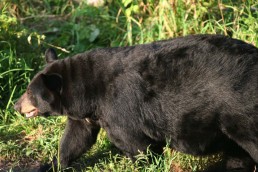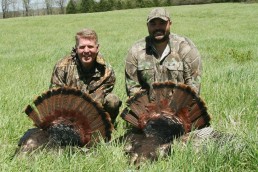Canadian Bear Hunt: Spring or Summer?
SHARE THIS POST
When it comes to hunting bears over bait, there always seems to be plenty of excitement. It’s rare that you’ll find yourself at a bear bait with absolutely nothing going on. I’ve been on several hunts with outfitters and all were able to put bears in front of me. Looking back over many hunts in Canada, I’ve failed to come home with a bear a couple times. In both cases I screwed up the shot opportunities. But I have learned a lot about bear hunting, both for the spring and fall. The two hunts are quite different in many ways, and I have a list of the things that make each hunt unique so let’s take a look at the advantages and disadvantages of spring vs. fall bear hunts.
Weather
Obviously, the first thing that comes to mind is the variation in weather conditions when comparing spring hunts to ones in the fall. Bear hunts in late August into early September can be characterized by pleasant weather with little rain and lots of sunshine. Well into September an overnight frost is not uncommon, but the days are likely to be warmer with many hours spent on stand.
Spring weather can be like that too, but it’s more likely to rain during May or early June hunts. Snow in May is not out of the question, and some parts of Canada can be very windy in the spring. On one hunt in Manitoba I felt like I was going to get blown out of my treestand. When on a spring hunt, it’s a good idea to bring clothing for hot weather and cold weather. You might need both on the same day.
The time spent on stand can be very long in spring. The sun sets late in the North Country. In northern Manitoba, I’ve been there at 10:30 p.m. and could clearly see my sight pins to make an ethical shot. Keep in mind the longest day of the year is the third week in June and the farther north you are hunting, the longer the days are. This can make a hunt seem like an ordeal if the weather is bad. Fortunately, you will likely have bears around you well before dark at this time of the year, which helps take your mind off adverse conditions.
Supplemental opportunities
I don’t hunt in the spring other than ones for bears. I don’t care for turkey hunting and there isn’t much else available in spring, so bears fill a nice place in my early-season schedule. I do fish, and I have had some great experiences on bear hunts. Trout, walleyes and northern pike seem to have the feedbag on during May and early June. The big northern pike will normally be in the shallows at this time and the action can be fast and furious. I have been on a couple hunts in Manitoba where the outfitter was on shallow-water lakes. Lake Manitoba is one and the other was Lake St. Martin. The bowfishing for carp was fantastic as we shot carp in the mornings and hunted bears in the afternoon.
I don’t like to sit around camp waiting to be taken to the stand, so I’ll look for other things to do when I decide to book a hunt. Springtime gets the edge in this category.
Numbers of bears
You will see more bears in the spring. It’s that simple—you will have more shot opportunities and more bears at the baits in this season than you will on a fall hunt. This is due to the bears being hungry and there is less available natural food so they tend to visit the baits more often and rely on them as their primary food source more in spring than the fall.
During fall hunts there is generally an abundance of natural food competing for the bears’ attention. Depending on where you are hunting it could be acorns and other nuts, berries, mushrooms, salmon in the streams, corn or oats. Baits in the fall tend to be supplements to the bear’s diet. By contrast, a bait in the spring is likely to be the first option, and sometimes the only one. This means there are a lot of bears depending on the bait, and action is likely to be steady.
Nocturnal bears are usually an issue in fall. Some come in well before dark in the spring. After all, if it doesn’t get dark until after 10 p.m. and then daylight is at 3:30 a.m., it’s hard to stay the word “nocturnal” without getting really hungry. Springtime bears are at the baits in the daylight and there is a lot of interaction going on which further entices them to come in early.
Are you enjoying this post?
You can be among the first to get the latest info on where to go, what to use and how to use it!
Speaking of interaction, there is another important factor in the springtime: the rut. Big male bears begin to seek out females in the middle of May, and by early June they are actively involved in the process of reproduction. These big males know where the baits are and they know the females will be found near the food. Spring is a great time to shoot a pumpkin-headed boar that wouldn’t be caught dead during the daylight at a bait in the fall.
The big and the beautiful
If you are into shooting a 500-pound bear, then fall is the time to go. Bears weigh more in fall than they do in spring. A boar that would go 300 pounds in May can weigh nearly twice as much by September. If you are looking for a giant and weight is more important to you than skull size, a fall hunt is for you. Sometimes late-spring bears can be pretty big too. In fact, there was a 600-pounder shot in June at my favorite Manitoba hunting destination, Grandview Outfitters.
During August and September there is no interest in breeding or any of the other distractions bears are faced with in spring. Their entire focus is on eating so they tend to really fill up when they are at the baits and then go sleep it off nearby. That’s an advantage to the hunter who wants to bag a big bear.
The pelt of the bear is significantly different at the various times of the year. Springtime pelts tend to be long and luxurious with heavy guard hairs and thick fur around the neck and shoulders. In the late summer, those guard hairs are gone and fur is finer so the pelt has a sheen to it. Some people like the look of a sleek pelt and others like the heavy look of a thick spring pelt. Whether a rug or a mount, the choice is up to you.
Rubbing can be an issue in the spring, as Bears tend to start scratching when the weather warms up. Rubs appear on the hips first, but can also be found on the shoulders and sides, even the back. These bald-looking spots can be troublesome for a mount or a rug, but often they’re on the back half of their body so a half-mount solves the problem.
Equipment concerns
Black flies, gnats, mosquitoes and other pests can make a hunt unpleasant, but they tend to be worse in the spring. The warm, dry weather of the summer can thin them down somewhat, but I always have a ThermaCELL with me. Springtime hunts can be muddy affairs so I make sure I have rubber boots, and if I am driving to a hunt I toss in a pair of hip boots, just in case. And, you may not need rubber boots in the fall.
When the sun gets lower and the air starts to get colder in fall you have to dress accordingly. In spring, however, anything goes. I like to take layers of clothing so I can pick and choose what to wear that particular day. And I never leave camp without a warm jacket. Once on a hunt in Saskatchewan I got in the stand at 3 p.m. wearing thin pants and a T-shirt under a long sleeve shirt. I had a hooded sweatshirt for later. At 5 p.m., a front moved through and dropped the temperature from 70 to 50 degrees in less than an hour. The north winds bit right through me and I shivered for four hours that night. I vowed I would never again go to the stand without a coat.
Take rain gear along on every hunt, too. You are more likely to use it on a spring hunt, but I never leave home for a hunt without good camouflaged rain gear. Another item in the bottom of my pack is a warm hat. When it cools off in the evening, I pull it down over my ears, which can make a colder evening more comfortable.
So there you have my comparison of spring hunts to fall hunts and the differences between them. If you were looking for me to offer you an opinion on which one is better, sorry to disappoint you but I am not willing to choose nor am I willing to give one up in favor of the other.
Did you enjoy this post?
You can be among the first to get the latest info on where to go, what to use and how to use it!
Bernie Barringer
Bernie Barringer has hunted big game with a bow in more than a dozen states and in multiple Canadian provinces. Passion drives him to learn more and hunt new places, and this column is your ticket to his travels. The author of 13 books and thousands of articles, you can find even more from him at bowhuntingroad.com and BowhuntingRoad on YouTube.

